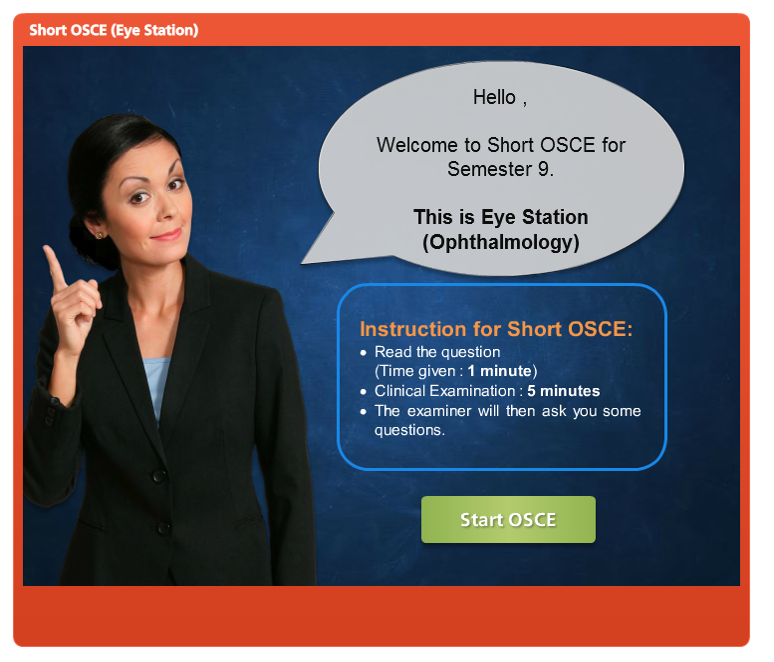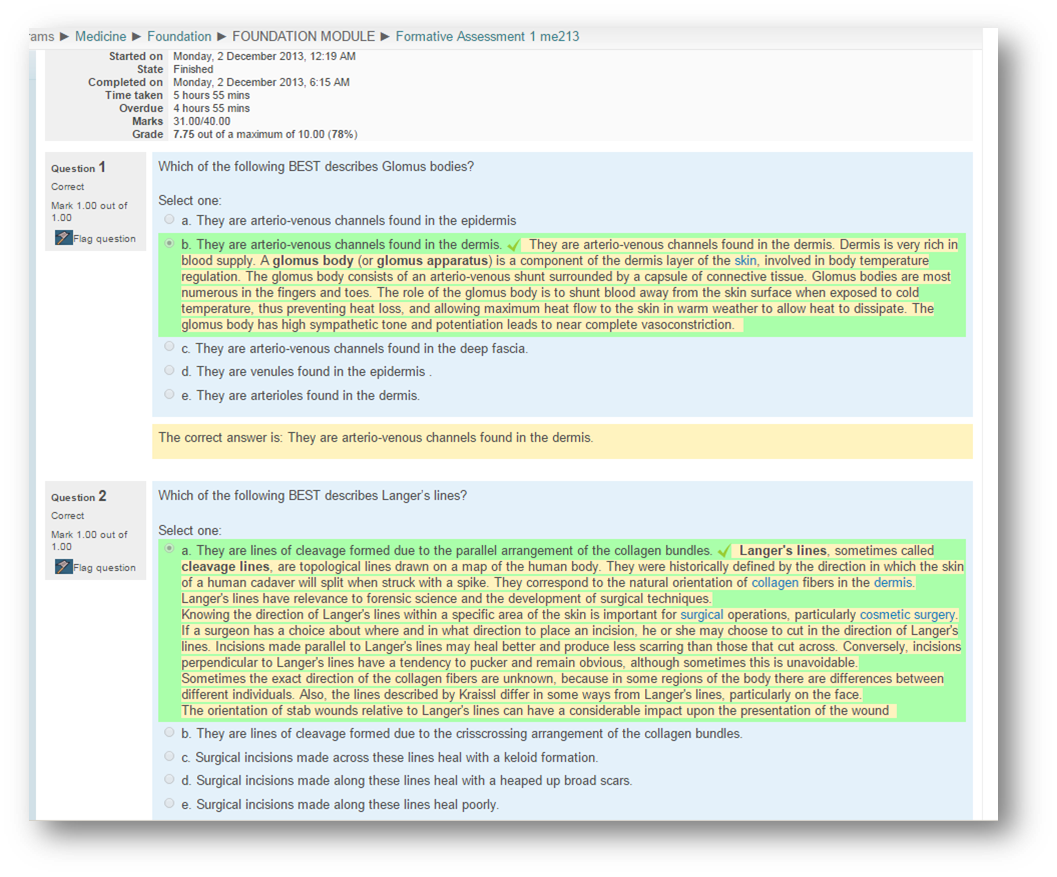


Theme
4AA eLearning courses
INSTITUTION
International Medical University -Kuala Lumpur, Malaysia
Medicine comprises a vast collection of knowledge, skills and attitudes. The trainee practitioner must achieve a large number of learning objectives within each of these so‐called domains of learning to be considered competent to practice. The acquisition of learning objectives in both undergraduate and postgraduate medical education can be achieved by a mixture of modalities including apprenticeship, didactic teaching (lecturing), self-study and small group learning. The recent rapid development of information technology has allowed electronic learning or “e-learning” to obtain a place in the “teaching toolbox” (Choules, 2007).
Over the years medical education has undergone significant evolution in this digital world. Blending all teaching and learning activities and assessment with eLearning would enhance the student learning experience and can be effectively utilised for teaching and assessing undergraduate as well as postgraduate medical students. In International Medical University (IMU) many forms of eLearning tools are used for online assessment which provides support and enhances the student learning experience.
In the various modules in our curriculum across Phase I (Semesters 1 to 5) and Phase II (Semesters 6-10) many types of online assessment using e-learning are done. These include Formative assessments(OBA,OSPE and OSCE), Summative assessments(OBA,EMQ and OSPE), Assigned independent reading topics, Elective reports, General Practice posting reports, Reflective reports,Community Oriented project,Clinical competencies,Online interactive quizzes,Portfolio, and Case summaries. The various eLearning components of the modules were extracted by using a quantitative questionnaire with the Likert scoring scale ranging from 1 to 4. Different templates for the questionnaires were used for the modules in Phase I and II of the medical curriculum.These questionnaires are generally administered to the students at the end of the module.The students are able to access the questionnaire through our elearning portal.Students are encouraged to answer all the components of the questionnaire and maximum student response is encouraged by the module coordinators.
The effectiveness of various components of the eLearning such as usefulness in gathering information provided, regarding eLearning promoting interactive/peer learning, feedback on assessment and appropriateness and fairness of assessment were evaluated from the period of January 2014 to December 2014. Many different cohorts of students were evalauted to assess the various components of the elearning.The mean scores across the cohorts and both phases varied from 2.49 to 3.43.
The results were tabulated for Phase I and Phase II as follows:
| Semester | Module | Response rate | Item | Mean | Standard deivation |
| One | Foundation | 91.3% | Q1 | 2.93 | 0.708 |
| Q2 | 2.62 | 0.796 | |||
| Two | Cardiovascular | 65.74% | Q1 | 2.98 | 0.647 |
| Q2 | 2.54 | 0.701 | |||
| Two | Haematology | 39.8% | Q1 | 3.03 | 0.519 |
| Q2 | 2.59 | 0.658 | |||
| Two | Respiratory | 32.1% | Q1 | 2.86 | 0.571 |
| Q2 | 2.49 | 0.704 | |||
| Three | Reproductive | 48% | Q1 | 2.89 | 0.705 |
| Q2 | 2.51 | 0.765 | |||
| Three | Gastrointestinal | 28% | Q1 | 2.97 | 0.520 |
| Q2 | 2.68 | 0.651 | |||
| Four | Renal | 55.7% | Q1 | 2.94 | 0.615 |
| Q2 | 2.71 | 0.648 | |||
| Four | Musculoskeletal | 73.21% | Q1 | 2.97 | 0.543 |
| Q2 | 2.65 | 0.610 | |||
| Five | Forensic Group A | 46.15% | Q1 | 3.00 | 0.587 |
| Q2 | 2.87 | 0.681 | |||
| Five | Forensic Group B | 40.3% | Q1 | 3.00 | 0.555 |
| Q2 | 2.63 | 0.688 | |||
| Five | Forensic Group C | 47.69% | Q1 | 2.97 | 0.547 |
| Q2 | 2.81 | 0.543 | |||
| Five | Forensic Group A | 26.32% | Q1 | 3.10 | 0.553 |
| Q2 | 2.90 | 0.788 | |||
| Five |
Forensic Group B |
6.58% | Q1 | 3.00 | 0.707 |
| Q2 | 3.00 | 0.707 | |||
| Five | Forensic Group C | 34.21% | Q1 | 3.08 | 0.560 |
| Q2 | 2.96 | 0.528 |
The mean scores ranged from 2.49 to 3.10.The lowest response rate was 6.58%.
Legend
Q1- Elearning was useful in gathering more information
Q2- Elearning promoted interactive/peer learning
| Semester | Posting/Module | Response rate | Item | Mean | Standard Deviation |
| Six | Family Medicine | 55.93% | Q1 | 3.08 | 0.563 |
| Q2 | 3.17 | 0.646 | |||
| Six | Internal Medicine | 55.93% | Q1 | 3.17 | 0.414 |
| Q2 | 3.11 | 0.468 | |||
| Six | Surgery | 55.08% | Q1 | 3.28 | 0.545 |
| Q2 | 3.43 | 0.553 | |||
| Six | Family Medicine | 70% | Q1 | 3.07 | 0.504 |
| Q2 | 3.18 | 0.512 | |||
| Six | Internal Medicine | 70% | Q1 | 3.22 | 0.459 |
| Q2 | 3.24 | 0.543 | |||
| Six | Surgery | 70% | Q1 | 3.20 | 0.487 |
| Q2 | 3.31 | 0.466 | |||
| Seven | Medical block | 69.57% | Q1 | 3.11 | 0.441 |
| Q2 | 3.12 | 0.488 | |||
| Seven | Psychiatry | 69.57% | Q1 | 3.27 | 0.512 |
| Q2 | 3.11 | 0.594 | |||
| Seven | Surgery | 69.57% | Q1 | 3.02 | 0.577 |
| Q2 | 3.11 | 0.475 | |||
| Seven | Orthopaedic | 69.57% | Q1 | 2.92 | 0.625 |
| Q2 | 2.92 | 0.680 | |||
| Seven | Medical block | 39% | Q1 | 3.04 | 0.464 |
| Q2 | 3.02 | 0.571 | |||
| Seven | Psychiatry | 39% | Q1 | 3.15 | 0.589 |
| Q2 | 3.15 | 0.589 | |||
| Seven | Surgery | 39% | Q1 | 3.04 | 0.509 |
| Q2 | 3.02 | 0.571 | |||
| Seven | Orthopaedic | 39% | Q1 | 2.94 | 0.604 |
| Q2 | 2.81 | 0.711 | |||
| Eight | Paediatrics | 46% | Q1 | 3.05 | 0.394 |
| Q2 | 3.03 | 0.362 | |||
| Eight | Obstetrics&Gynaecology | 45% | Q1 | 3.34 | 0.481 |
| Q2 | 3.32 | 0.525 | |||
| Eight | Paediatrics | 49.45% | Q1 | 3.13 | 0.505 |
| Q2 | 3.29 | 0.506 | |||
| Eight | Obstetrics&Gynaecology | 49.45% | Q1 | 3.40 | 0.495 |
| Q2 | 3.40 | 0.580 | |||
| Nine | Family&Community health | 72.73% | Q1 | 3.14 | 0.484 |
| Q2 | 3.15 | 0.522 | |||
| Nine | Medical block | 72.73% | Q1 | 3.17 | 0.411 |
| Q2 | 3.10 | 0.535 | |||
| Nine | Surgical block-Anaesthetic | 72.73% | Q1 | 3.32 | 0.499 |
| Q2 | 3.29 | 0.535 | |||
| Nine | Surgical block-Surgery | 72.73% | Q1 | 3.22 | 0.451 |
| Q2 | 3.19 | 0.493 | |||
| Nine | Family&Community health | 79.80% | Q1 | 2.96 | 0.542 |
| Q2 | 3.14 | 0.445 | |||
| Nine | Medical block | 79.80% | Q1 | 3.00 | 0.453 |
| Q2 | 3.13 | 0.516 | |||
| Nine | Surgical block-Anaesthetic | 79.80% | Q1 | 3.41 | 0.673 |
| Q2 | 3.47 | 0.618 | |||
| Nine | Surgical block-Surgery | 79.80% | Q1 | 3.10 | 0.524 |
| Q2 | 3.13 | 0.589 |
The mean scores ranged from 2.92 to 3.47.The highest response rate was 79.8%.
Legend
Q1- Assessment was appropriate and fair
Q2- Feedback on assessment



Increasing numbers of medical schools are using the internet. Students value online lecture notes to supplement their reading. The clinical encounter lies at the heart of medical training. A blended approach to e-learning could be an achievable method. New methods of instruction are being developed to augment traditional teaching. (Thakore and McMahon, 2006)
Elearning for teaching and assessment has been widely accepted among members of the faculty at International Medical University.eLearning for assessment is an important part of learning and teaching and the portal can be used as a platform in addition to being used for putting up material for teaching and learning. This also promotes learning from the feedback provided for the various online assessments. There is also the proposal by Ministry of Education in Malaysia on increasing the eLearning component to 10-30% which would only enhance the student learning experience.
-
Choules A.P. 2007. The use of elearning in medical education: a review of the current situation. Postgraduate Medical Journal 83(978): 212-216.
-
Kathleen Scalise & Bernard Gifford.Computer-Based Assessment in E-Learning:A Framework for Constructing“Intermediate Constraint” Questions and Tasks for Technology Platforms.The Journal of Technology, Learning, and Assessment.Volume 4, Number 6 · June 2006.
-
Thakore H., McMahon T. 2006. Virtually there: e-learning in medical education. The Clinical Teacher 3: 225–228.
There are many advantages in the use of Elearning for assessment.These are as follows:
1.Formative assessment - helps to drive learning by assessment.
2.Summative assessment by elearning is better than paper-based assessment since it has an advantage by it's ability to generate statistics,provides feedback to students and faculty and is paper-free.
All universities worldwide are moving towards assessment using elearning.
I would like to thank the Elearning department at the International Medical University for providing the necessary input and information in the preparation of this eposter.
 Send Email
Send Email